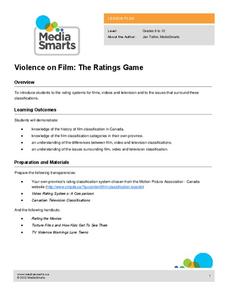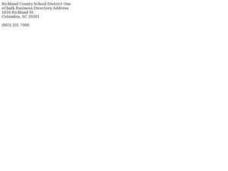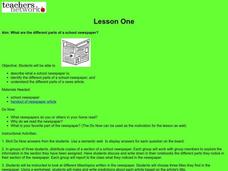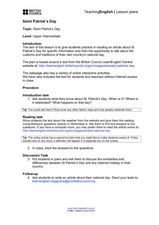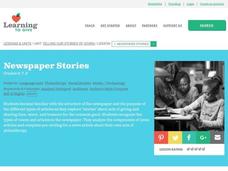American Museum of Natural History
Cosmic Cookies
Scholars read about each planet then bake a plate of cosmic cookies—no-bake cookies decorated to look like the planets; Mercury, Venus, Earth, Mars, Jupiter, Saturn, Uranus, Neptune, and Pluto.
Media Smarts
Violence and Video Games
Widespread video gaming makes this content relevant and high interest. Developing youth awareness about the impact of violence in games is important to promote literacy, critical thinking, health, and consumer awareness. After reading...
Media Smarts
Violence on Film: The Ratings Game
Learn about film and TV ratings systems in Canada (includes a comparison to the MPAA system) and how they influence appropriate viewing for youths. A detailed commentary about the film Seven pointed at revealing flaws in ratings systems...
NASA
How Rockets Work
Now, that's some fire power! A five-page handout provides a description of the basics of how rockets work. The reading explains Newton's Laws of Motion by beginning with defining some of the important terms. The article finishes by...
WE Charity
High School–Module 2: Circular Economy and Nature
Everyone's heard the popular slogan reduce, reuse, recycle, but there may be a better way to talk about sustainability. Using the second lesson from the five-part WE Are Innovators—High School Modules series, learners explore issues...
Penguin Books
A Guide to the Works of Jacqueline Woodson
The works of Jacqueline Woodson introduce readers to diverse characters and themes. A guide covers many of the author's best-known books such as Brown Girl Dreaming and Locomotion. Dive & Discuss and Explore & Extend activities...
Teaching Tolerance
Why Do We (Still) Celebrate Columbus Day?
What are we really celebrating on Columbus Day? The resource explores the narrative behind Columbus Day and ways for people to change the perception. Scholars also review vocabulary terms associated with the topic and how attitudes have...
Children’s Hospital of Philadelphia
Vaccine History and Research
It all becomes a matter of timing. Groups use a variety of resources to research the history of vaccines by first creating a timeline of vaccine research using leading scientists' work. Learners read articles to develop a story of the...
Nemours KidsHealth
Depression: Grades 6-8
Over two lessons, scholars examine depression—what it is, signs of it, and ways to cope. Through discussion, reading articles, writing a resource, and completing worksheets, participants make their way through the learning process,...
Nemours KidsHealth
Germs: Grades 6-8
As part of their study of bacteria, viruses, fungi, and protozoa, middle schoolers create engaging public service announcements for preschool and kindergarten classes, teaching them how and when to wash their hands. To begin, class...
Anti-Defamation League
Bias, Bullying and Bad Behavior in the NFL
A 2014 case of locker room behavior in the National Football League offers high schoolers an opportunity to get involved in the conversation of bullying and abuse. Class members read about the case and analyze quotes that reveal...
Anti-Defamation League
Implicit Bias
Everyone has biases, both explicit—ones we are aware of—and implicit—ones we are unaware of. High schoolers learn the differences between explicit and implicit bias in a short lesson where pupils watch a short video, read articles about...
Curated OER
Science Summaries are the Bomb!
Fifth graders read a dissection article and complete close reading activities for the text. In this reading skills lesson, 5th graders read an interactive frog dissection article in teams. Student teams complete a KWL chart and...
Curated OER
Let the Pictures Tell the Story: Presenting a Point of View
Ninth graders examine the process of writing a newspaper article that presents a point of view. They read various newspaper articles, analyze methods of persuasive writing, interpret and create editorial cartoons, and write an editorial.
Curated OER
School Newspaper
Students analyze the different parts of a school newspaper. In this newspaper lesson, students complete a semantic web activity for newspapers and explore a newspaper in groups. Students create a write a report for the information....
Curated OER
Here Ye! Here Ye! Read All About It!
Fourth graders explore the internet to find articles to read. In this reading comprehension lesson plan, 4th graders take notes on articles found on the internet. Students use the writing process to summarize the selected articles.
Curated OER
Found Poems
Students summarize articles found in the newspaper and use key concepts to write a poem. In this reading comprehension and writing lesson plan, students work with a partner to choose a current newspaper article. Key concepts and...
Curated OER
Saint Patrick's Day
Pupils read an article about Saint Patrick's Day and answer short answer questions about what they read. In this Saint Patrick's Day lesson plan, students answer 17 questions total.
Curated OER
Population - Technical Reading
Students analyze a technical article about population growth and present possible solutions.
Curated OER
Canaima
Students analyze the meaning and uses of definite articles in Spanish. They read a pamphlet on the national park in Canaima, Venezuela, and discuss the similarities and differences between national parks in the U.S. and Venezuela.
Curated OER
Comments
Young scholars evaluate newspaper articles. In this newspaper article lesson plan students compare newspaper articles. They comment on headlines, language choices, quality and clarity, and impact on the reader.
Curated OER
Newspaper Stories
Students examine the structure of the newspaper. In this newspaper lesson, students look at the different types of articles about giving, sharing, and acts for the common good. They realize the types of voice that are used in the...
Curated OER
Where Oh Where
Students read a current event article orally and make connections regarding the geographic themes of the newspaper location. In this current event article lesson, students use a map to locate where the event from their...
Curated OER
Understanding the News
Pupils work in small groups to identify the following categories of news articles: hard news, features, announcements, and opinion/personal reflection.


